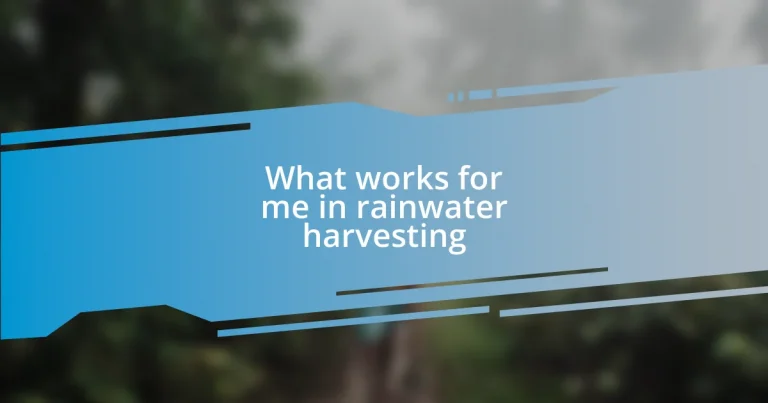Key takeaways:
- Rainwater harvesting reduces dependence on municipal systems, lowers water bills, and strengthens personal connections to nature.
- Key components include a collection roof, gutters and downspouts, and appropriately sized storage tanks for effective water management.
- Regular maintenance, such as cleaning gutters and inspecting tanks, is essential for the system’s longevity and water quality.
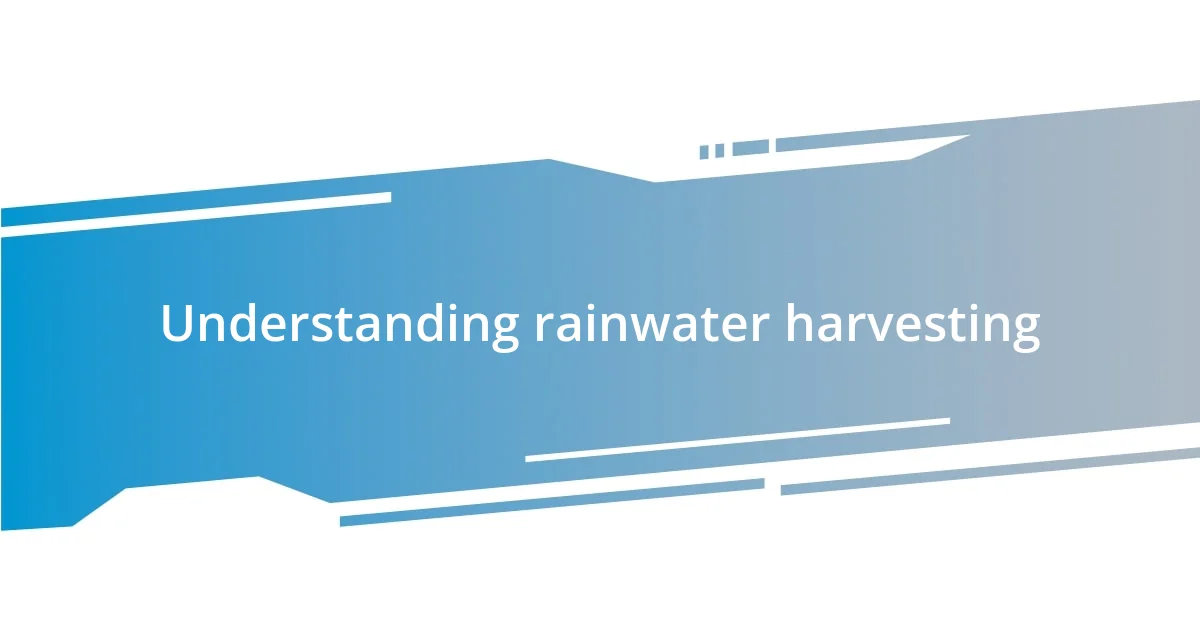
Understanding rainwater harvesting
Rainwater harvesting is essentially the process of collecting and storing rainwater for future use. I remember the sense of satisfaction I felt when I installed my first rain barrel; it made me realize how much water could be captured right from my roof. It’s fascinating to think about how this simple act can reduce reliance on municipal water systems and lower water bills.
Understanding the technology behind rainwater harvesting is crucial. The system typically involves gutters and downspouts that channel rainwater into storage tanks or barrels. Isn’t it remarkable how such a basic system can provide a sustainable water source? I often find myself reflecting on the simplicity of it all; we’re just redirecting a natural resource that’s freely available, yet so many overlook it.
Moreover, rainwater harvesting isn’t just about saving water; it fosters a deeper connection to the environment. I’ve noticed that when I fill my watering can with rainwater, it feels more meaningful than using tap water. It’s like nurturing my garden with something pure and natural. Have you ever stopped to think about how you interact with water on a daily basis? This practice invites us to reconsider that relationship and embrace a more eco-friendly lifestyle.
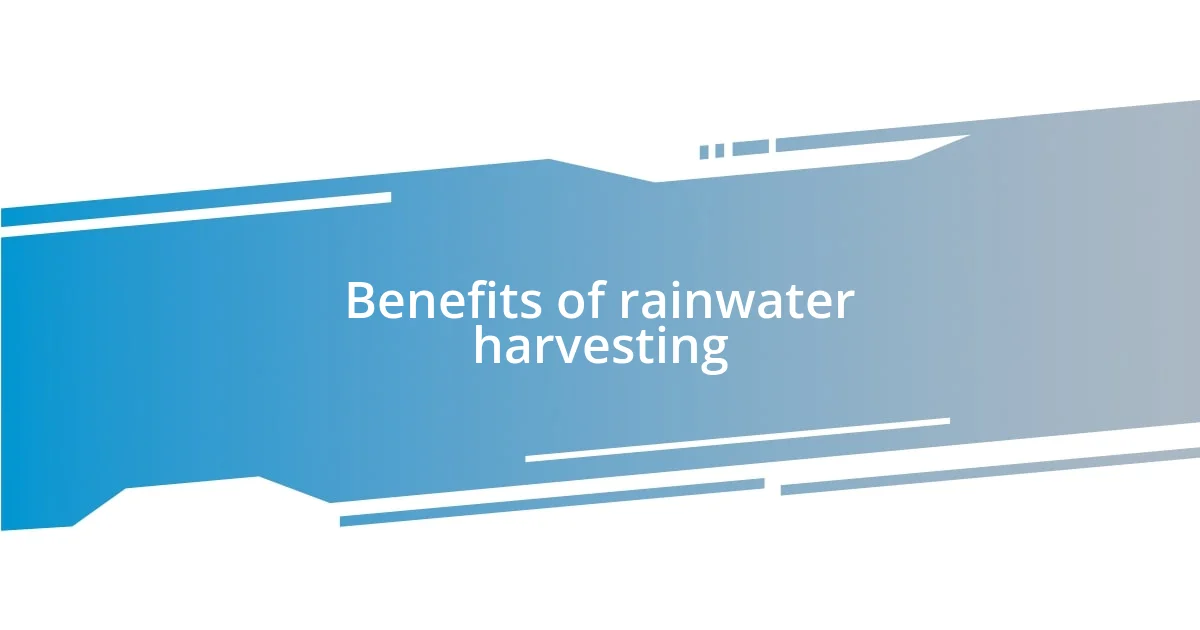
Benefits of rainwater harvesting
Rainwater harvesting brings several undeniable benefits that extend beyond just saving on your water bill. Personally, I’ve experienced a noticeable improvement in my garden’s health since I started using rainwater. The plants seem to thrive better, possibly because the rainwater is free from the chemicals found in municipal supplies. There’s something incredibly rewarding about watching my plants flourish, knowing I’m using a natural resource that would otherwise go to waste.
Here are some key benefits of rainwater harvesting:
- Cost Savings: Reduces water bills by providing an alternative water source.
- Environmental Impact: Decreases demand on local water supplies and reduces stormwater runoff.
- Water Quality: Rainwater is often cleaner and free from chemicals that may be present in treated water.
- Drought Resilience: Provides a backup water source during dry spells, enhancing water security.
- Self-Sufficiency: Promotes independence from municipal water systems, allowing for greater control over water use.
Reflecting on my experience, I often think about those dry summer days when every drop counts. Having that stored rainwater felt like having a little safety net, ready to nourish my garden even when the sky wasn’t providing. Ultimately, it’s more than just practical; it’s an intimate way to engage with nature while respecting the resources we have.
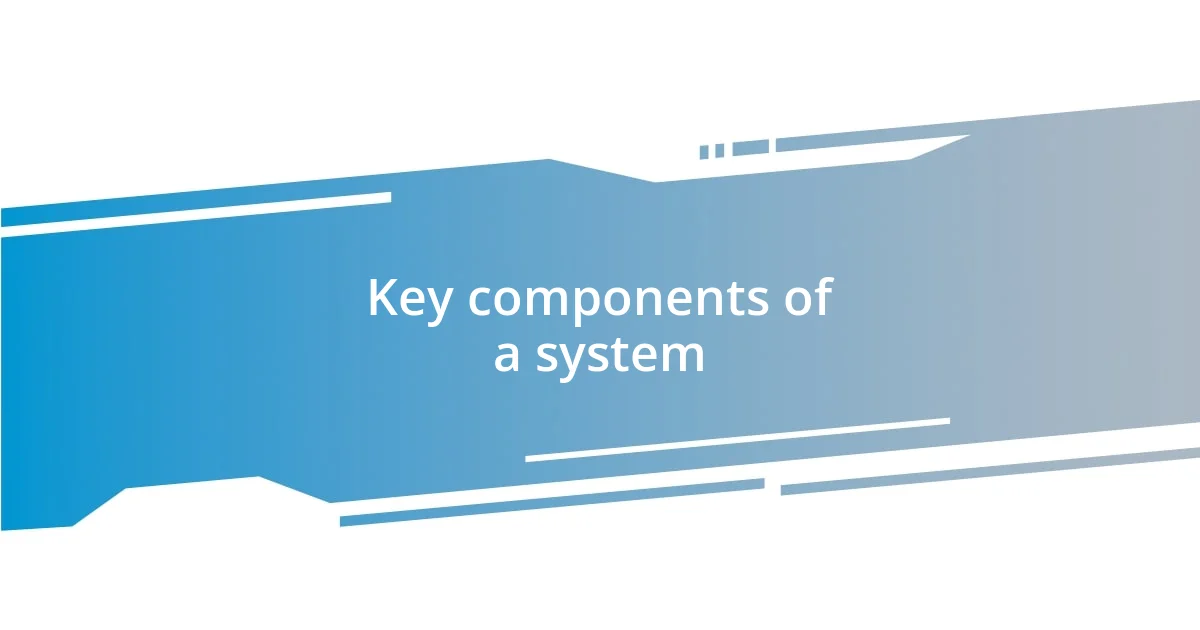
Key components of a system
When considering the key components of a rainwater harvesting system, the first step is the roof. It acts as a collection point, where the rainwater begins its journey. I still remember the first time I stood on my roof, watching rainwater trickle down into my gutters. It was such a transformative experience, realizing that the very thing that often caused me stress—a leaky roof—could become a resource.
Next is the gutter and downspout system, which channels the collected rainwater into storage solutions. I’ve found a well-designed gutter system can make all the difference. There were days when my enthusiasm led me to install a DIY system that turned out to be quite messy, spilling more water than it collected. That taught me the importance of functional designs and proper slope; every angle must help guide the rainwater efficiently to where it’s needed most.
Finally, there’s the storage tank or barrel, where the magic really happens. In my experience, a properly sized tank means you’re not just collecting water; you’re securing your supply. I once underestimated this aspect and ran out of stored rainwater midway through a particularly hot summer. That taught me the value of thinking ahead and understanding my household’s needs. This way, the system becomes integrated into your lifestyle, supporting your needs while making the most of nature’s gifts.
| Component | Function |
|---|---|
| Roof | Collection point for rainwater |
| Gutters and Downspouts | Channel water to storage |
| Storage Tank or Barrel | Reserve water for later use |

Selecting the right materials
Selecting the right materials for your rainwater harvesting system is crucial for efficient collection and storage. I’ve found that materials like food-grade plastic for barrels and galvanized steel for gutters are durable options that provide longevity and resilience. Remember when I switched to a metal roof? The transformation was eye-opening; the rainwater collection nearly doubled due to the smooth surface and pitch that directed all the water effectively.
It’s also important to consider the fittings and seals that keep your system watertight. I once overlooked the significance of high-quality seals, which led to leaks that wasted precious water. Could you imagine the frustration of collecting rainwater only to watch it slip away? Investing in good fittings is essential to maintain the integrity of your system and ensure that every drop counts.
Another aspect I’ve discovered is the impact of color and texture on storage tanks. Darker tanks can prevent algae growth, which can taint your stored water. I learned this the hard way after noticing a greenish hue in my initial, lighter tanks. It’s those lessons that really highlight how choosing the right materials doesn’t just affect functionality; it directly influences the quality of what you’re collecting. So, what materials will you consider for your own setup? It’s all part of the journey towards creating an efficient, sustainable system.

Designing an efficient catchment
Designing an efficient catchment revolves significantly around how you configure your roof and its pitch. I once played with different angles on my roof, realizing that a steeper pitch allowed water to flow more freely into the gutters. Have you ever noticed how the tiniest adjustments can lead to massive improvements? Slightly altering the slope created a noticeable difference in the volume of water I collected during a storm.
In addition to the roof’s pitch, considering the materials used is vital. I experimented with various roof types, and I learned that a smoother surface, like metal or tiles, significantly enhances water runoff compared to rougher textures. Did you know that even something as simple as a clean roof can impact your system? After a particularly heavy rain, I saw just how much dirt and debris could hinder my collection, reminding me to regularly maintain it for optimal performance.
Finally, think about the surrounding landscape. I strategically placed rain barrels close to my gutters, but I also made sure that the area was clear of any obstacles that could hinder water flow. I remember the time I neglected to remove some nearby shrubs; during a rainstorm, I felt the frustration of seeing water pooling in places it shouldn’t. Isn’t it amazing how the environment plays such a crucial role in our rainwater harvesting success? It’s all about creating a seamless system where every element works in harmony, capturing nature’s bounty effectively.
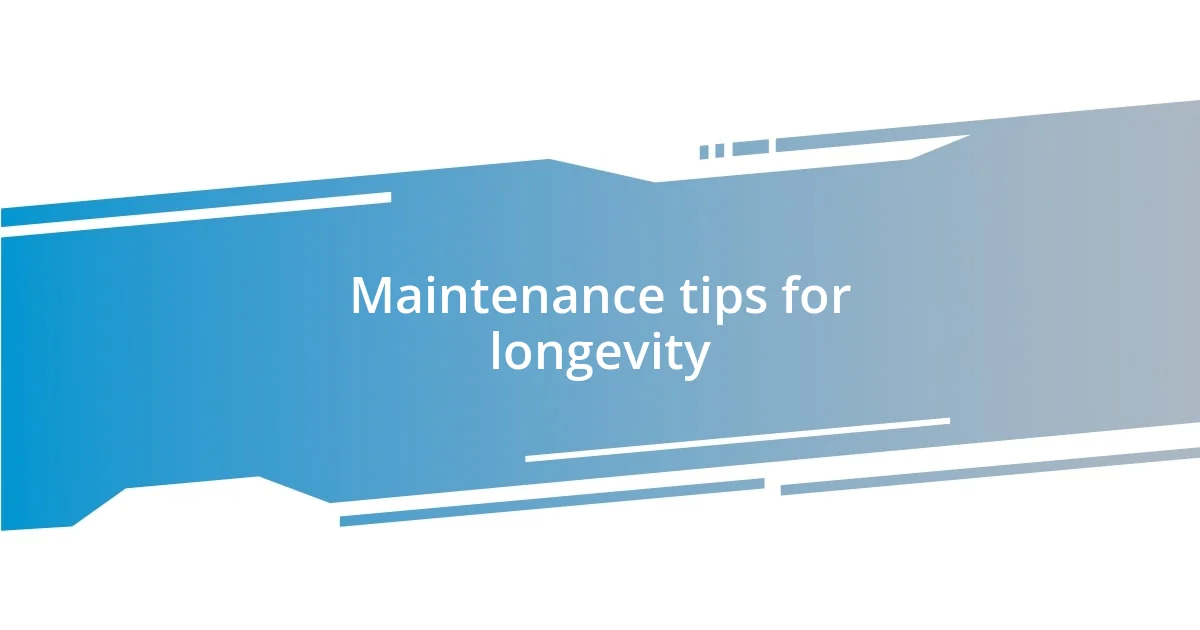
Maintenance tips for longevity
Maintenance is vital for ensuring the longevity of your rainwater harvesting system. I remember the first time I cleaned my gutters after a storm; the sheer amount of debris that had collected surprised me. Imagine thinking you’re ready for rain only to find your system clogged! Regularly clearing out leaves and dirt not only prevents blockages but also allows for more efficient water collection.
Another tip I swear by is inspecting the storage tanks for any signs of wear and tear. I had a small crack in one of my tanks that I ignored for too long, resulting in a slow leak that wasted precious water. It’s like having a tiny hole in your savings account—if you don’t catch it early, it can end up costing you significantly. Now, I make it a point to check my tanks every few months; better safe than sorry, right?
Finally, don’t underestimate the power of regular system flushing. Early on, I neglected this step, leading to some incredibly unpleasant surprises on hot summer days. The first taste of stagnant water was an eye-opener. Flushing out the system not only keeps the water fresh but also minimizes the risk of algae growth. How refreshing is it to know that a simple routine can keep your water clean and inviting?

Real life success stories
One story that stands out for me is my neighbor, Sarah, who transformed her tiny urban garden into a thriving oasis through rainwater harvesting. I watched in awe as she installed a series of well-placed rain barrels, which not only caught every drop but also watered her plants across different levels of her garden. It’s inspiring to see how her little initiative not only saved water but also turned her space into a habitat for butterflies and birds—proof that sustainability can nurture nature as well.
I also remember a community project where we combined efforts with local schools to teach children about the importance of conserving water. We set up an educational installation where students could engage directly with rainwater collection methods. Witnessing their excitement and curiosity reminded me of the power of sharing knowledge. How amazing is it to think that planting seeds of awareness can lead to a broader movement for sustainable practices in the younger generation?
Then there was the time I took part in a workshop on rain garden design. It was fascinating to hear from attendees who shared their own successes, like converting paved pathways into beautiful gardens that absorbed rainwater intelligently. I felt a sense of camaraderie among us, sharing trials and triumphs alike. Isn’t it heartening to know that every success story, big or small, can inspire others to take meaningful steps in their own rainwater harvesting journeys? It reminds me just how impactful community spirit can be in striving for a sustainable future.












